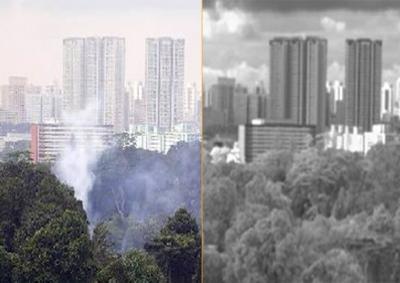The Latin prefix “infra” means “below” or “beneath”. Thus “infrared” refers to the region beyond or beneath the red end of the visible color spectrum. The infrared region is located between the visible and microwave regions of the electromagnetic spectrum. Because heated objects radiate energy in the infrared, it is often referred to as the heat region of the spectrum. All objects radiate some energy in the infrared, even objects at room temperature and frozen objects such as ice.
The higher the temperature of an object, the higher the spectral radiant energy, or emittance, at all wavelengths and the shorter the predominant or peak wavelength of the emissions. Peak emissions from objects at room temperature occur at 10 µm. The sun has an equivalent temperature of 5900 K and a peak wavelength of 0.53 µm (green light). It emits copious amounts of energy from the ultraviolet to beyond the far IR region.
Much of the IR emission spectrum is unusable for detection systems because the radiation is absorbed by water or carbon dioxide in the atmosphere. There are several wavelength bands, however, with good transmission. The long wavelength infrared (LWIR) band spans roughly 8-14 µm, with nearly 100% transmission on the 9-12 µm band. The LWIR band offers excellent visibility of most terrestrial objects. The medium wavelength infrared (MWIR or MIR) band (3.3-5.0 µm) also offers nearly 100% transmission, with the added benefit of lower, ambient, background noise. Visible and short wavelength infrared (SWIR) or near infrared (NIR) light (0.35-2.5 µm) corresponds to a band of high atmospheric transmission and peak solar illumination, yielding detectors with the best clarity and resolution of the three bands. Without moonlight or artificial illumination, however, SWIR imagers provide poor or no imagery of objects at 300K.
Shortwave Infrared (SWIR) Technology
SWIR or shortwave infrared detectors offer unique capabilities that are often complementary to LWIR and MWIR imagers. A SWIR detector is a photodetector, just as a cooled LWIR or MWIR detector. Unlike LWIR or MWIR imaging, SWIR imaging uses (mainly) reflected light. This is very similar to visible cameras or the human eye. Therefore SWIR images are comparable to (black and white) visible images in the rendering of the scenes.
The recent use of InGaAs material has caused a breakthrough for not-cryogenically cooled SWIR imagers. InGaAs SWIR detectors typically use a Peltier cooler and have a sensitivity in the SWIR band from 900 to 1700 nm. However, InGaAs based imagers can be tuned to support VisNIR cameras that are sensitive in the visible wavelength range thus providing a response from 400 to 1700 nm.

SWIR cameras can be used for day and night (starlight) imaging, which is a big advantage over other technologies. Other important advantages are the small size, lower power, maintenance-free (compared to cooled detectors), the ability to see covert lasers and very short events (are high speed and global shutter), and the ability to see through protective glass (unlike MWIR and LWIR detectors) making the SWIR imagers particularly well suited for high temperature and hot processes monitoring. A number of materials have specific behaviors in the SWIR band of the spectrum making the use of SWIR imagers very well suited for detection or analysis. A few examples:
- Water: high absorption in SWIR band: Moisture and water leaks detection
- Silicon and related: very low absorption in SWIR band: see-through for defect detection and alignment
- Some gases (CO2, methane..) have specific signature in SWIR band.
- Plastics have high absorption in SWIR band
- Organic and non-organic materials have specific signatures in SWIR. That feature is very useful in food and waste sorting
Midwave Infrared (MWIR) Technology
The MWIR region is also referred to as “thermal infrared” because radiation is emitted from the object itself and no external light source is needed to image the object. Two major factors determine how bright an object appears to a thermal imager: the object’s temperature and its emissivity (a physical property of materials that describes how efficiently it radiates).
As an object gets hotter, it radiates more energy and appears brighter to a thermal imaging system. Atmospheric obscurants cause much less scattering in the MWIR band than in the SWIR band, so cameras sensitive to these longer wavelengths are highly tolerant of smoke, dust and fog.
MWIR collects the light in the 3 μm to 5 μm spectral band. MWIR cameras are employed when the primary goal is to obtain high-quality images rather than focusing on temperature measurements and mobility.
Longwave Infrared (LWIR) Technology
For several decades, infrared cameras based on LWIR (longwave infrared) and MWIR (midwave infrared) sensors have been used by the military for detecting human activity. These infrared cameras detect thermal emissions of humans, vehicles, animals as they stand out when the environment has a different temperature.

For LWIR sensors we distinguish between the common uncooled LWIR microbolometer sensors, and the much more exotic cooled LWIR sensors.
An uncooled LWIR microbolometer is a thermal sensor with basically a resistor in every pixel. The microbolometer structure itself is usually made of amorphous silicon (a-Si) or Vanadium-oxide (Vox). The resistance value will change depending on the amount of incident radiation, because the incident infrared radiation will heat up the resistor structure. This resistance change in every pixel is then measured and processed, and then used to create an image. Typically the microbolometer structure is optimized for best sensitivity for wavelengths between 8 and 14 µm.
A LWIR cooled detector is a photodetector and typically uses semiconductor materials such as HgCdTe (Mercury-Cadmium-Telluride) or QWIP (Quantum Well Infrared Photodetector) materials. A photodetector uses a semiconductor to convert photons into electrons (or more accurately: electron-hole pairs). The most common photodetector is the silicon CCD used in most cell phone cameras (for visible light). Depending on the application, LWIR photodetectors need to be cooled to 77K or below, for example by using a Stirling cooler. Typically, these detectors are sensitive for wavelengths between 7 and 12 µm.